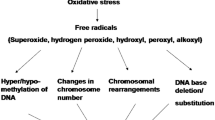Abstract
Aloe vera L. Burm. f. is used as a popular folk medicine with many cultivars growing naturally or in cultivation in different parts of the world. The present report describes the methods of in vitro propagation and conservation as well as detailed chromosomal analysis of two morphologically indistinguishable cultivars of Aloe vera obtained from NBPGR at the CAZRI (Central Arid Zone Research Institute), Jodhpur, India. The study shows the highly conserved orthoselected karyotype in Aloe vera both in in vivo and in vitro grown cultivars. Cytological investigation of one in vitro raised plant revealed its tetraploid nature. Fourteen chromosomes were resolved into 7 bivalents during meiosis of both the cultivars. Percentage of pollen viability is high in both the cultivars yet the flowers failed to form fruits. Pollen mitosis was used to prepare haploid karyotypes in our study.



Similar content being viewed by others
References
Abraham Z, Prasad PN. Occurrence of triploidy in Aloe vera Tourn. ex Linn. Curr Sci. 1979;48:1001–2.
Adams SP, Leitch IJ, Bennett MD, Chase MW, Leitch AR. Ribosomal DNA evolution and phylogeny in Aloe (Asphodelaceae). Am J Bot. 2000;87(11):1578–83.
Brandham PE. The chromosomes of the Liliaceae. II. Polyploidy and karyotype variation in the Aloineae. Kew Bull. 1971;25:381–99.
Brandham PE, Doherty MJ. Genome size variation in the Aloaceae, an angiosperm family displaying karyotypic orthoselection. Ann Bot. 1998;82(Supplement A):67–73.
Bruneton J. Pharmacognosy, Phytochemistry Medicinal Plants. Paris, Lavoisier Publishing 1995;363–4.
Cutler DF, Brandham PE, Carter S, Harris J. Morphological, anatomical, cytological and biochemical aspects of evolution in East African shrubby species of Aloe L. (Liliaceae). Bot J Linn Soc. 1980;80:293–317.
Davis RH et al. Anti-inflammatory and wound healing of growth substance in Aloe vera. J Am Podiatr Med Assoc. 1994;84:77–81.
Davis RH et al. Aloe vera, hydrocortisone, and sterol influence on wound tensile strength and anti-inflammation. J Am Podiatr Med Assoc. 1994;84:614–21.
Davis RH, Maro NP. Aloe vera and gibberellins anti-inflammatory activity in diabetes. J Am Podiatr Med Assoc. 1989;79:24–6.
Fine A, Samuel MD. Cultivation and clinical application of Aloe vera leaf. Radiology. 1938;31:735–6.
Grindlay D, Reynolds T. The Aloe vera phenomenon: a review of the properties and modern uses of the leaf parenchyma gel. J Ethno Pharma. 1986;16:17151.
Grover JK, Yadav S, Vata V. Medicinal plants of India with anti-diabetic potential. J Ethno Pharma. 2002;81:81–100.
Heggers JP, Pelley RP, Robson MC. Beneficial effects of Aloe in wound healing. Phytother Res. 1993;7:S48–52.
Huziwara Y. The karyotype analysis in some genera of Compositae X. The chromosomes of some European species of Aster. Bot Mag. 1962;75:143–50.
Levan A, Fredga K, Sandberg A. Nomenclature for centromeric position on chromosomes. Hereditas. 1964;52:201–19.
Marchi P, Illuminati O, Macioce A, Capineri R, D’amato G. Genome evolution and polyploidy in Leucanthemum vulgare Lam.aggr. (Compositae) Karyotype analysis and DNA micro densitometry. Caryologia. 1983;36:1–18.
Mohanty BD, Ghosh PD, Maity S. Chromosomal analysis in cultured cells of barley (Hordeum vulgare L.). Structural alterations in chromosomes. Cytologia. 1991;56:191–7.
Newton LE. In defense of the name Aloe vera. The cactus and succulent. J Great Britain. 1979;41:29–30.
Roberts VA. Relationship between species in the genus Rosa, Section Pimpinellifolia. Bot J Linn Soc. 1977;74:309–28.
Sharma AK. A new concept of a means of speciation in plants. Caryologia. 1956;9:93–130.
Sharma AK, Sharma A. Chromosome techniques – theory and practice. 3rd ed. London: Butterworths; 1980.
Shelton RM. Aloe vera, its chemical and therapeutic properties. Int J Derm. 1991;30:679–83.
Singh JP, Dhuria HS. Studies on floral biology of sweet lime. Ind J Hort. 1960;17:9–20.
Stebbins GL. Cytological characteristics associated with the different growth habits in the dicotyledons. Am J Bot. 1938;25:189–98.
Vij SP, Sharma M, Toor IS. Cytogenetical investigations into some garden ornamentals II. The genus Aloe L. Cytologia. 1980;45:515–32.
Vijayavalli B, Mathew PM. Studies in south Indian Liliaceae: III. Cytology of twelve species of Aloe. New Bot. 1990;17:255–66.
Winters WD, Benavides R, Clouse WJ. Effects of Aloe extracts on human normal and tumor cells in vitro. Econ Bot. 1981;35:89–95.
http://www.nmpb.nic.in. Medicinal plants database.
Acknowledgements
Authors are thankful to NBPGR, CAZRI, Jodhpur, India for providing the plant material and to the Plant Biotechnology Laboratory, Department of Botany, Presidency College, Kolkata for providing necessary funds and facilities.
Author information
Authors and Affiliations
Corresponding author
Rights and permissions
About this article
Cite this article
Das, A., Mukherjee, P., Ghorai, A. et al. Comparative karyomorphological analyses of in vitro and in vivo grown plants of Aloe vera L. BURM. f.. Nucleus 53, 89–94 (2010). https://doi.org/10.1007/s13237-010-0001-1
Received:
Published:
Issue Date:
DOI: https://doi.org/10.1007/s13237-010-0001-1




